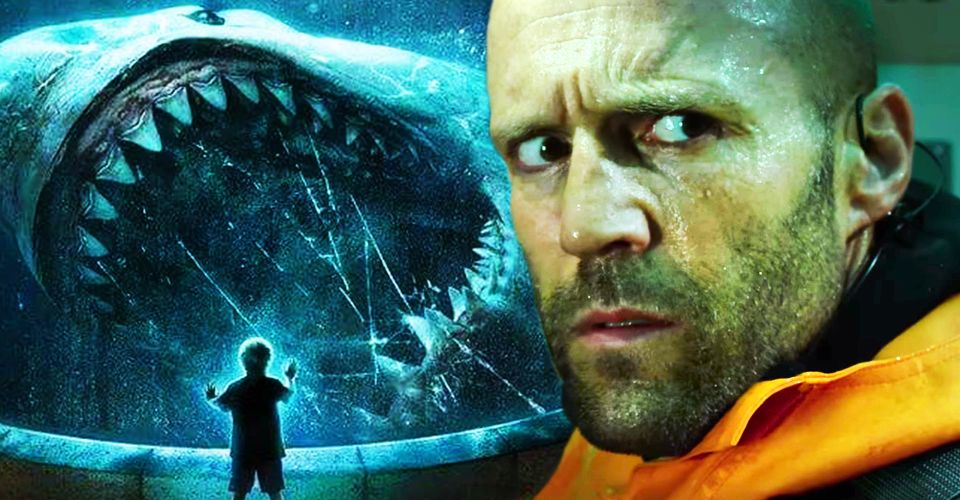The Meg: The Shark Movie’s Biggest Mistakes (& How The Sequel Can Fix Them)

The Meg wasn’t as terrifying as it could have been, but a sequel can fix that problem easily. Helmed by National Treasure director Jon Turteltaub and loosely based on Steve Alten’s sci-fi horror book Meg: A Novel of Deep Terror, The Meg finally escaped development hell after more than 20 years in limbo. As one would expect from the premise of Jason Statham fighting a humongous shark, the movie was an action-packed summer blockbuster that grossed over $530 million worldwide. However, The Meg had the potential to become another landmark in the “killer shark” horror subgenre, which can still be exploited in the sequel.
The Meg tells the story of Jonas Taylor (Jason Statham), a rescue diver who hunts down the Carcharodon Megalodon, a prehistoric 80-foot creature that killed part of his crew five years prior. Of course, Jonas is hesitant to face the creature again, but he accepts the mission when his ex-wife, Lori (Jessica McNamee) gets stranded in the depths of the Mariana Trench. Jonas Taylor joins the billionaire Jack Morris (Rainn Wilson), Dr. Minway Zhang (Winston Chao), and the oceanographer Suyin (Li Bingbing) in a rescue mission that quickly becomes a grueling quest for survival. Thankfully for Lori and the entire coast of China, Jonas manages to fight the Megalodon into submission before leaving its corpse for smaller sharks to feast on.
Although The Meg was a box office hit and received enough positive reviews in spite of its outlandish premise, it wasn’t nearly as memorable as Steven Spielberg’s horror classic Jaws, or as rich in mythology as the ever-expanding MonsterVerse (otherwise known as the Godzilla franchise). This is a significant weakness in a movie that has so much franchise potential. After all, the sub-genre of Kaiju action/horror movies isn’t as populated as the superhero or the haunted house sub-genres.
The Biggest Mistakes The Meg Made

All of the flaws one could find in The Meg derive from its lack of faith in its own concept. Yes, the fact that it was finally released after so long was already a triumph, but the saturation of VFX-heavy Hollywood blockbusters is requiring large-scale movies to have a more distinctive style. The Meg wasn’t scary enough to be considered a horror movie by most audiences, nor was it funny enough to be considered a parody of disaster movies. It was action-packed and over-the-top, but it wasn’t self-aware enough to rival Jason Statham’s action hero shenanigans in the Fast & Furious movies. In short, The Meg played it too safe to remain in the collective memory of the audience until the next aquatic monster movie comes out.
This is most clearly reflected in The Meg‘s PG-13 rating. It’s only logical for a movie about a shark dozens of times bigger than Jaws‘ iconic Bruce to be more graphic. Blood and gore don’t necessarily have to be gratuitous or disgusting like in the Piranha movies, but the freedom to show an ominous floating limb or a grisly on-screen death is a powerful tool that can serve the plot in multiple beneficial ways, like setting up how unrelenting the shark is or how no character is truly safe. Take, for example, Deep Blue Sea and the infamous scene where the shark comes out of nowhere to snatch Russell Franklin (Samuel L. Jackson) into the water. Dated visual effects notwithstanding, that’s the most memorable moment for many viewers thanks to its brutal depiction of the attack.
The most evident pitfall in The Meg is that it doesn’t take a strong stance on its horror roots. Crawl takes a straightforward route on the premise of a looming creature in a single location, Open Water makes use of found footage to create a suspenseful survival thriller, and The Reef uses footage of real sharks to increase the sense of realism. All of these movies picked a solid tool to spark a sense of fear and stuck to it, adopting a well-defined style of horror. The Meg‘s closest tool was its high-octane action, but it failed to resemble any kind of horror, save from a few obligatory jump scares that are inherent to deep-sea movies.
How The Meg 2 Can Be A Better Shark Horror Movie

First of all, The Meg 2 needs to hold onto what made the first movie successful. All of the performances in The Meg surpassed the expectations for a movie of this type with a nice balance of humor and action. Granted, Rainn Wilson’s Jack Morris is fish food now, but Shuya Sophia Cai’s Meiyin and Fan Bingbing’s Suyin still have more potential to become influential players in the sequel. With these characters secured, The Meg 2 needs to give them a different role in the story than the ones countless other shark movies have used. Although the titular Megalodon is dead, the sequel also needs to establish a more threatening antagonist with a logical narrative connection to the events of the first movie in order to keep the stakes high. It isn’t enough to just pit Jason Statham against a bigger shark.
The Meg 2 can learn a thing or two from The Shallows. Jaume Collet-Serra’s 2016 suspense horror achieved a higher amount of thrills and drama than The Meg with only a vulnerable protagonist, a rock, a seagull, and the concealed presence of a non-monstrous great white shark. In an era when the T-Rex is the least threatening dinosaur in the Jurassic World movies, monster-centric films need to find more creative ways to awaken fear in the audience. The Meg lifted the most common tropes from killer shark movies that date all the way back to Jaws, but still ignored the subtler parts of Spielberg’s classic, like building up the looming presence of the shark while the creature is off-camera.
Cabin Fever and Hostel director Eli Roth was attached to helm The Meg at one point, but later dropped out of the project due to creative differences with the studio. It’s easy to see how Roth’s idiosyncratic vision clashed with Warner Bros’ desire to make an action movie fit for all audiences. Unfortunately for the studio, that decision is bound to find some serious obstacles a second time since the movie’s concept won’t be so fresh as it was the first time. Drawing inspiration from other successful offerings in the killer shark sub-genre to make The Meg 2 a fully-fledged horror movie is a great way to avoid stagnation, or worse, a critical and commercial failure.
Open Water and The Reef have proven that shark movies are scarier without CGI, but The Meg 2 shouldn’t—and probably couldn’t—go to those extremes. What the sequel really needs to understand is that bigger isn’t always better, even when its main appeal is the size of the monster. If The Meg‘s sequel doesn’t follow this path, it can still embrace how over-the-top it is and approach the action with less restraint in order to make the Megalodon’s attacks more visibly terrifying.
About The Author

















